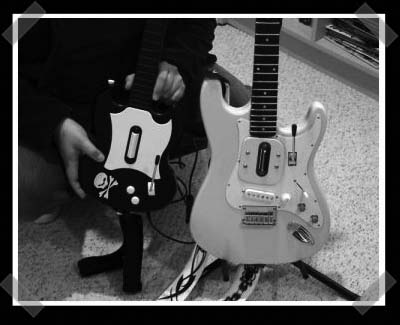
If you thought your Guitar Hero controller was only good for pretending to play music, think again. Yeah, lots of people have hacked the controller to achieve perfect scores, but what can you do that doesn’t require a console. Look after the break for some more creative ways of making music with a Guitar Hero controller.
Day O’ Guitar Hero Mods (with A Bonus)

I’ve already gotten a pile of tips on Guitar Hero controllers today, so here we go. The first one is already making the rounds. [Mark] replaced strummer with a touchscreen LCD and a magnetic switch. [Mark]s ultimate goal is to add some optical sensing and make the guitar self playing. For details, hit the acidmods thread or just watch the proof of concept demo.
[Johan] sent in the second controller of the day, and it’s probably my favorite for guitar bling. The original mushy switches were replaced with micro-switches and CNC milled replacement buttons. Each button is individually lit with LEDs and a cold cathode lights up translucent panel in the body. A PIC controller controls the lights and provides some input options for button tapping. The video is actually pretty entertaining to watch.
For a little bonus, check out [Mastershake916]’s cast Hack-A-Day pendant.
Wireless Guitar Hero Controller

[John] sent in his PS3 wireless guitar hero project. The concept seems popular today. Hopefully he’ll write up some instructions – but it looks pretty straight forward – he embedded a normal PS3 controller inside the body of the guitar hero controller. For now you can gaze upon the high res version. Update: He passed along a couple more shots of the project. Update2: Here’s the instructables on building your own.
Guitar Hero Guitar Controller

[Chuck] sent me this How-To on building your own custom Guitar Hero controller. I love the idea – the stock controller is a bit small for me. This one was built for a Child’s Play fund-raiser, so maybe you can score it and help get some games to some kids in need.
Remember, there are just 20 more days to get your entry in for the Design Challenge!
$30 Guitar Build Shows What You Can Do With Amazon Parts
Most guitarists buy their axes fully assembled from big names like Fender, Gibson, and… maybe Yamaha? Sure. But there are a dedicated set that relish in mixing and matching parts and even building and assembling their own instruments. [Danny Lewis] decided to see what he could do with the cheapest guitar parts from Amazon and a body of his own design, and he put together something pretty passable for just $30.
The wood for the body was cut on a bandsaw, and was essentially free scrap sourced from old furniture. [Danny] went for an unconventional design using a roughly Telecaster outline and large cutouts either side of the bridge. The neck was free, by virtue of being an old Harmony neck sourced off Craigslist. We’d have preferred to see what could be done with a cheap Amazon neck, but it nonetheless fits the vibe of the build.
The guitar then received a $9.99 pickup and controls, an $8.80 solidtail bridge, and $11 tuning machines for the headstock. Strung up, it actually sounds passable. We’d want to throw it on a proper amp and give the whole thing a setup before fully assessing it, but hey, for $30, it’s hard to go wrong.
We do love some hacky guitars around here; we’ve even featured some with surprise effects gear built into the bodies. Video after the break.
Continue reading “$30 Guitar Build Shows What You Can Do With Amazon Parts”
Lego Guitar Is Really An Ultrasonically-Controlled Synth
The phrase “Lego Guitar” can be a stressful one to hear. You might imagine the idea of strings under tension and a subsequently exploding cloud of plastic shrapnel. This build from the [Brick Experiment Channel] eschews all that, thankfully, and is instead a digital synth that only emulates a guitar in its rough form factor.
The heart of the build is a Lego Mindstorms EV3 controller. It’s acts as the “body” of the guitar, and is fitted with a Lego “fretboard” of sorts. A slide is moved up and down the fretboard by the player. The EV3 controller detects the position of the slide via an ultrasonic sensor, and uses this to determine the fret the user is trying to play. The button the user presses on the controller then determines which of five “strings” the user is playing, and the selected note is sounded out from the EV3’s internal speaker. It’s strictly a monophonic instrument, but three different sounds are available: a bass guitar, a rock guitar, and a solo guitar, with all the fidelity and timbre of a 90s Casio keyboard.
It’s a fun and silly instrument, and also kind of difficult to play. The slide mechanism doesn’t offer much feedback, nor are the EV3 buttons intended for dynamic musical performance. Regardless, the player belts out some basic tunes to demonstrate the concept. We doubt you’d ever be able to play Through The Fire and Flames on such a limited instrument, but [Brick Experiment Channel] used their editing skills to explore what that might sound like regardless.
We’ve seen some other great synth guitars before, too. Modern microcontrollers and electronics give makers all kinds of creative ways to build electronic instruments with unique and compelling interfaces. Some are more successful than others, but they’re all fun to explore. Video after the break.
Continue reading “Lego Guitar Is Really An Ultrasonically-Controlled Synth”
Electric Guitar Shocks You For Missing A Note
Rocksmith is a popular video game that works like Guitar Hero, but with a real guitar. You have to play well and hit the right notes, or the game penalizes your score. [Lightwing] took the stakes up a notch, though, adding a system that shocks the player every time they fail.
To achieve this, it was necessary to detect when the player missed a note. Initial attempts involved using Tensor Flow AI to detect the game state from the screen, but it was unreliable. Instead, the game’s memory was read to achieve detection. When the player misses a note, a certain section of memory changes, and a script reads the change in game state. It then sends a signal to an Arduino which triggers the stun gun’s fire button, which shocks the player holding the guitar.
As you might expect, the documentation for this project includes a video which involves plenty of gratuitous electric shocks when [Lightwing] makes mistakes. Fair warning — there’s plenty of colorful language when the stun gun fires. Generally, a powerful shock ends with screams a dropped guitar, and too much fear to continue.
It’s painful enough that it’s probably not a useful teaching tool for learning the guitar. We’ve seen similar shocking builds before, too, like this simple wire game.
Continue reading “Electric Guitar Shocks You For Missing A Note”














